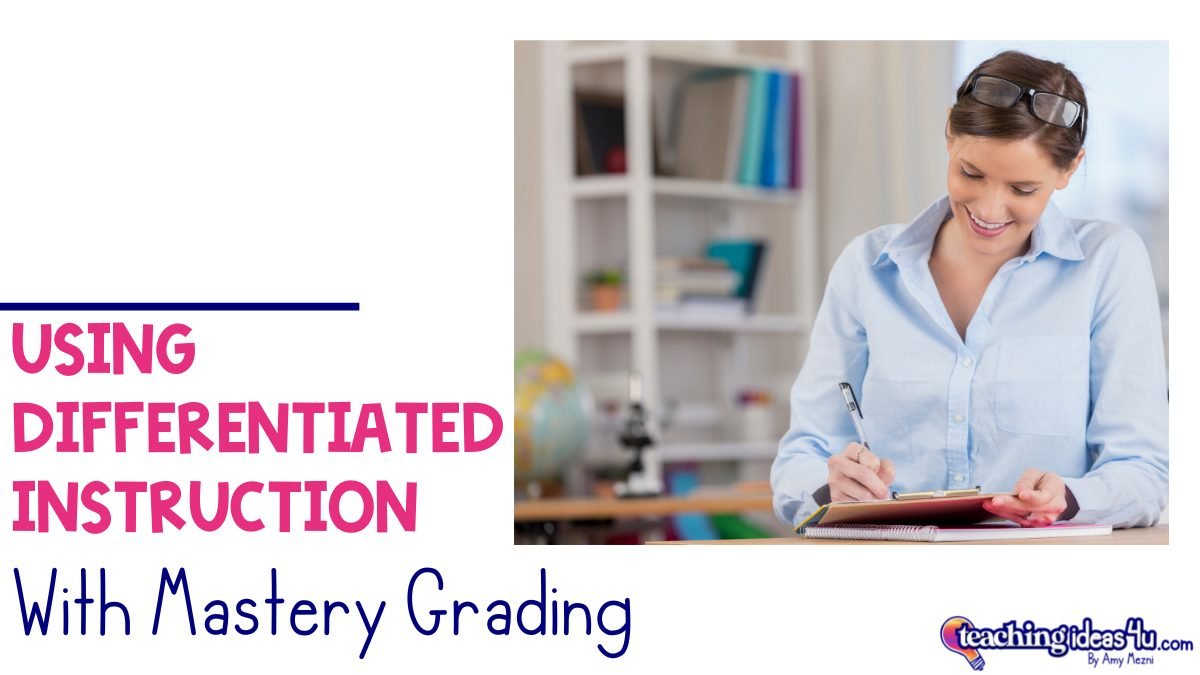Differentiated Instruction With Mastery Grading
In mastery-based learning, students can self-evaluate, inquire, and accept criticism to develop their mastery of skills and objectives.
Teaching your students to effectively participate in this process makes determining the learning needs of your students easier. Once you know each students’ strengths and weaknesses, you can differentiate instruction.
Why Does Student Engagement Matter?
As a teacher, you know all curriculum should be aligned to the standards your students need to master, and you should follow best practices for planning those lessons, including small groups, independent practice, direct instruction, teacher/student feedback, assessment, and peer review.
Mastery grading promotes student engagement through scoring instead of actually grading students’ practice work.
The practice of scoring creates a rhythm of instruction (the rhythm being practice - feedback - assessment) for each unit you teach. In many cases, there will be multiple instances of practice - feedback before you get to assessment.
Student engagement also promotes student risk-taking and work completion. Practice work is scored on the level of completeness rather than correctness, reducing students’ fear of failure and increasing their willingness to attempt the practice.
This increase in student engagement is what makes determining their learning needs easy and effective.
How Can You Determine Learning Needs?
Metacognition is the understanding of thought processes, including what you know and don’t know. Students who hone in on self-evaluation (which builds metacognition) participate in active feedback.
The practice-review-feedback loop should be accomplished within a short amount of time, no more than 10 -15 minutes.
It is important to develop a classroom routine where students are self-assessing and asking direct questions about the errors they’ve made and cannot figure out alone. These activities build metacognition, as they require students to think and reflect upon their learning.
Also, it is during this review that teachers should determine the learning needs of their students by looking for patterns in questions. You should make a mental note of the questions students have during the review period. These questions are what you should focus on during instruction and remediation, because they are the learning needs that your students have identified.
How Can I Use Mastery Grading To Differentiate Instruction?
Mastery grading relies on two things: collaborative learning and self-assessment. Every classroom is full of students with diverse needs, strengths, and requirements. Therefore, differentiated learning is a vital part of curriculum planning.
You should use the student feedback you receive during the practice review to determine what your students need. Then you can base your differentiation on the self-assessments, prior test scores, and IEP goals.
Collaborative Groups
One simple way you can differentiate learning is by creating needs-based groups. If you are in the middle of a unit that focuses on reading and analyzing information, students with similar reading and writing skills should be placed together.
An alternative to grouping by reading or writing level is to differentiate by skill. Place students that need a bit more support with a particular concept together, which allows you to focus on that concept with the students who have not yet mastered it.
Differentiated Materials
There are some instances where you may need to intentionally differentiate the materials you give to students based on their current level of understanding.
The key to differentiation is that the mastery skill that is being taught is still the focus, no matter which method of differentiation you choose.
As long as students are working toward mastery of a specific skill, the materials used can be differentiated according to student need. For example, let’s say you are working on determining the author’s support for their argument. If you have students who read at different levels, you could group them with students around the same ability level but give each group different texts. Differentiating the materials to meet the needs of the students allows them all to work on the target skill.
Note: It is important that rubrics (or scales or whatever else you use to evaluate) be given to students before they begin their differentiated activities. Reviewing the rubric at the beginning of the unit establishes the learning goals that students will work toward.
Peer Feedback
Student feedback from other students who are working on the same task is also an important part of this process. Students should discuss their learning with partners or small groups. It is in these small groups that students will discuss any differences in their responses or understanding, and often misconceptions can be corrected during these discussions.
Once this collaborative review of the assignment has been completed, each group can share its findings with the whole class. This enhances the focus on the mastery objective rather than on the materials or methods being used to achieve the objective.
Summative Assessments
Differentiated assessments should focus on the same standards established for mastery development.
When using summative assessments, you should reference any background information about your students (IEPs, prior assessments, etc.). Any summative assessment that uses differentiation should focus on the specific set of criteria that has been presented to students.
The absolute key to summative assessments is to only allow one attempt at each to truly evaluate the mastery level of your students. Only this will give you an effective assessment of the level of mastery your students actually attained.
Teachers can allow reassessments, but only after students have completed practice and feedback to improve their mastery.
By using mastery grading, you use feedback you receive from students during practice activities to determine their learning needs. Once you have identified those needs, you can easily differentiate instruction.
Do you have questions about differentiated instruction and mastery grading? Keep reading through my blog series and see if I answered them there!
Still have questions? Message me!
Click here for our Facebook Live On Mastery Grading!
Learn more about Mastery Grading with our blog series:
How to Grade for Mastery in Standard-Based Learning


